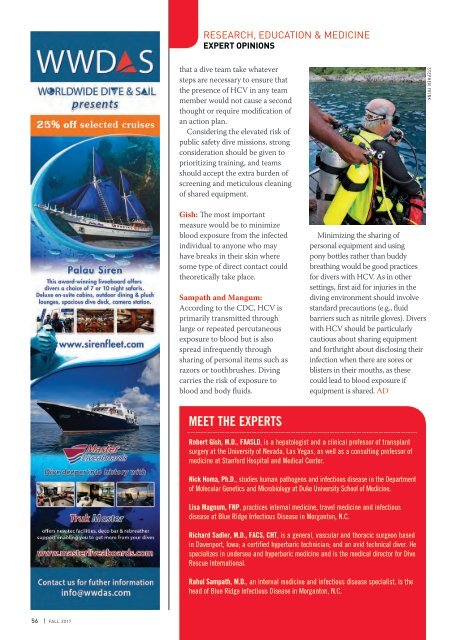AD 2017 Q4
Alert Diver is the dive industry’s leading publication. Featuring DAN’s core content of dive safety, research, education and medical information, each issue is a must-read reference, archived and shared by passionate scuba enthusiasts. In addition, Alert Diver showcases fascinating dive destinations and marine environmental topics through images from the world’s greatest underwater photographers and stories from the most experienced and eloquent dive journalists in the business.
Alert Diver is the dive industry’s leading publication. Featuring DAN’s core content of dive safety, research, education and medical information, each issue is a must-read reference, archived and shared by passionate scuba enthusiasts. In addition, Alert Diver showcases fascinating dive destinations and marine environmental topics through images from the world’s greatest underwater photographers and stories from the most experienced and eloquent dive journalists in the business.
Create successful ePaper yourself
Turn your PDF publications into a flip-book with our unique Google optimized e-Paper software.
RESEARCH, EDUCATION & MEDICINE<br />
EXPERT OPINIONS<br />
that a dive team take whatever<br />
steps are necessary to ensure that<br />
the presence of HCV in any team<br />
member would not cause a second<br />
thought or require modification of<br />
an action plan.<br />
Considering the elevated risk of<br />
public safety dive missions, strong<br />
consideration should be given to<br />
prioritizing training, and teams<br />
should accept the extra burden of<br />
screening and meticulous cleaning<br />
of shared equipment.<br />
Gish: The most important<br />
measure would be to minimize<br />
blood exposure from the infected<br />
individual to anyone who may<br />
have breaks in their skin where<br />
some type of direct contact could<br />
theoretically take place.<br />
Sampath and Mangum:<br />
According to the CDC, HCV is<br />
primarily transmitted through<br />
large or repeated percutaneous<br />
exposure to blood but is also<br />
spread infrequently through<br />
sharing of personal items such as<br />
razors or toothbrushes. Diving<br />
carries the risk of exposure to<br />
blood and body fluids.<br />
Minimizing the sharing of<br />
personal equipment and using<br />
pony bottles rather than buddy<br />
breathing would be good practices<br />
for divers with HCV. As in other<br />
settings, first aid for injuries in the<br />
diving environment should involve<br />
standard precautions (e.g., fluid<br />
barriers such as nitrile gloves). Divers<br />
with HCV should be particularly<br />
cautious about sharing equipment<br />
and forthright about disclosing their<br />
infection when there are sores or<br />
blisters in their mouths, as these<br />
could lead to blood exposure if<br />
equipment is shared. <strong>AD</strong><br />
STEPHEN FRINK<br />
MEET THE EXPERTS<br />
Robert Gish, M.D., FAASLD, is a hepatologist and a clinical professor of transplant<br />
surgery at the University of Nevada, Las Vegas, as well as a consulting professor of<br />
medicine at Stanford Hospital and Medical Center.<br />
Nick Homa, Ph.D., studies human pathogens and infectious disease in the Department<br />
of Molecular Genetics and Microbiology at Duke University School of Medicine.<br />
Lisa Magnum, FNP, practices internal medicine, travel medicine and infectious<br />
disease at Blue Ridge Infectious Disease in Morganton, N.C.<br />
Richard Sadler, M.D., FACS, CHT, is a general, vascular and thoracic surgeon based<br />
in Davenport, Iowa; a certified hyperbaric technician; and an avid technical diver. He<br />
specializes in undersea and hyperbaric medicine and is the medical director for Dive<br />
Rescue International.<br />
Rahul Sampath, M.D., an internal medicine and infectious disease specialist, is the<br />
head of Blue Ridge Infectious Disease in Morganton, N.C.<br />
56 | FALL <strong>2017</strong>









